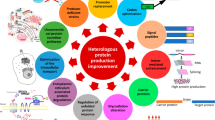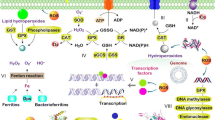Abstract
A study was made of calcium metabolism during germ tube formation inSporothrix schenckii yeast cells. A net efflux of calcium was observed very early in the transformation process and remained constant thereafter. The efflux of calcium in yeast cells induced to form germ tubes was twice that observed in yeast cells not induced to form germ tubes. Two peaks of calcium uptake were observed in germ tube forming yeast cells at 30 and 300 minutes following inoculation, while non-induced yeast cells, a continuous increase in uptake was observed which ultimately reached higher values than the ones obtained in germ tube forming cells. Substances which affect calcium metabolism in other cells such as cobalt ions, ionophore A23187 and compound R24571 were observed to inhibit germ tube formation and calcium uptake. In addition, ionophore A23187 was found to increase calcium efflux to approximately twice the control values. The inhibition of germ tube formation brought about by substances which inhibit calcium uptake or increase efflux suggests that the intracellular calcium concentration in these cells must be precisely regulated for the yeast to mycelium transition to occur.
Similar content being viewed by others
References
Alsina A, Rodríguez-del Valle N. Effects of Divalent Cations and Functionally Related Substances on the Yeast to Mycelium Transition inSporothrix schenckii. Sabouraudia: J Vet Med Mycol 1984; 22: 1–5.
Berridge MJ, Heslop JP, Irving RF, Brown KD. Inositol Triphosphate Formation and Calcium Mobilization in Swiss 3T3 Cells in Response to Platelet-Derived Growth Factor. Biochem J 1984; 222: 195–201.
Betancourt S, Torres-Bauzá LJ, Rodríguez-del Valle N. Molecular and Cellular Events During the Yeast to Mycelium Transition inSporothrix schenckii. Sabouraudia: J Vet Med Mycol 1985; 23: 207–18.
Combettes L, Berthon B, Claret M. Phospholipidic Second Messengers and Calcium. Biochemie 1987; 69: 281–6.
Cory JG, Carter GL, Karl RC. Calcium Ion-Dependent Proliferation of L1210 Cells in Culture. Biochem Biophys Res Commun 1987; 145: 556–62.
Dieter P, Marme D. For Red Light Irradiation of Intact Corn Seedings Affects Mitochondrial and Calmodulin Dependent Calcium Transport. Biochem Biophys Res Commun 1981; 101: 749–55.
Durant S, Homo F, Duval D. Calcium and A23187-Induced Cytolysis of Mouse Thymocytes. Biochem Biophys Res Commun 1980; 93: 385–91.
Gietzen K, Wuthrich A, Bader H. R24571: A New Powerful Inhibitor of Red Blood Cell Ca2+-Transport ATPase and of Calmodulin-Regulated Functions. Biochem Biophys Res Commun 1981; 101: 418–25.
Gomes SL, Mennucci L, Da Costa Maia JC. Calcium Efflux During Germination ofBlastocladiella emersonii. Dev Biol 1980; 77: 157–66.
Hagiwara S. Calcium Channel. Annu Rev Neurosci 1981; 4: 69–125.
Hesketh TR, Smith GA, Hously MD, Warren GB, Metcalfe JC. Is an Early Calcium Efflux Necessary to Stimulate Lymphocytes? Nature 1977; 276: 490–4.
Jensen P, Rasmussen H. The Effect of A23187 upon Calcium Metabolism in the Human Lymphocyte. Biochim Biophys Acta 1977; 468: 146–56.
Kaiser N, Edelman IS. Calcium Dependence of Ionophore A23187-Induced Lymphocyte Cytotoxicity. Cancer Res 1978; 38: 3599–603.
Miyakawa T, Tachikawa T, Jeong YK, Tsuchiya R, Fukui S. Transient Increase of Ca2+ Uptake as a Signal for Mating Pheromone-Induced Differentiation in the Heterobasidiomycetous YeastRhodosporidium toruloides. J Bacteriol 1985; 1304–6.
Moolenaar WH, Tertoolen LGJ, de Laat SW. Growth Factors Immediately Raise Cytosolic Free Ca+2 in Human Fibroblasts. J Biol Chem 1984; 259: 8066–9.
Muthukuman G, Nickerson K. Ca(II)-Calmodulin Regulation of Fungal Dimorphism inCeratocystis ulmi. J Bacteriol 1984; 159: 390–2.
Pouyssegur J. The Growth Factor Activatable Na+/H+ Exchange System: A Genetic Approach. Trends Biochem Sci 1985; 10: 453–5.
Reed PW, Lardy H. A-23187: A Divalent Cation Ionophore. J Biol Chem 1982; 250: 9428–30.
Resto S, Rodríguez-del Valle N. Yeast Cell Cycle ofSporothrix schenckii. J Vet Med Mycol 1984; 26: 13–24.
Rodríguez-del Valle N, Debs-Elías N, Alsina A. Effects of Caffeine Cyclic 3′, 5′ Adenosine Monophosphate and Cyclic 3′, 5′ Guanosine Monophosphate in the Development of the Mycelium Form ofSporothrix schenckii. Mycopathologia 1984; 86: 29–33.
Van Haastert PJM. cAMP Activates Adenylate Cyclase and Guanylate Cyclase ofDictiostelium discoideum Cells by Binding to Different Classes of Cell-Surface Receptors. A Study with Extracellular Ca2+. Biochim Biophys Acta 1985; 846: 324–33.
Walker GM, Sullivan PA, Shepherd M. Magnesium and the Regulation of Germ Tube Formation inCandida albicans. J Gen Microbiol 1984; 130: 1941–5.
Author information
Authors and Affiliations
Rights and permissions
About this article
Cite this article
Serrano, S., Valle, N.R.d. Calcium uptake and efflux during the yeast to mycelium transition inSporothrix schenckii . Mycopathologia 112, 1–9 (1990). https://doi.org/10.1007/BF01795170
Accepted:
Issue Date:
DOI: https://doi.org/10.1007/BF01795170




